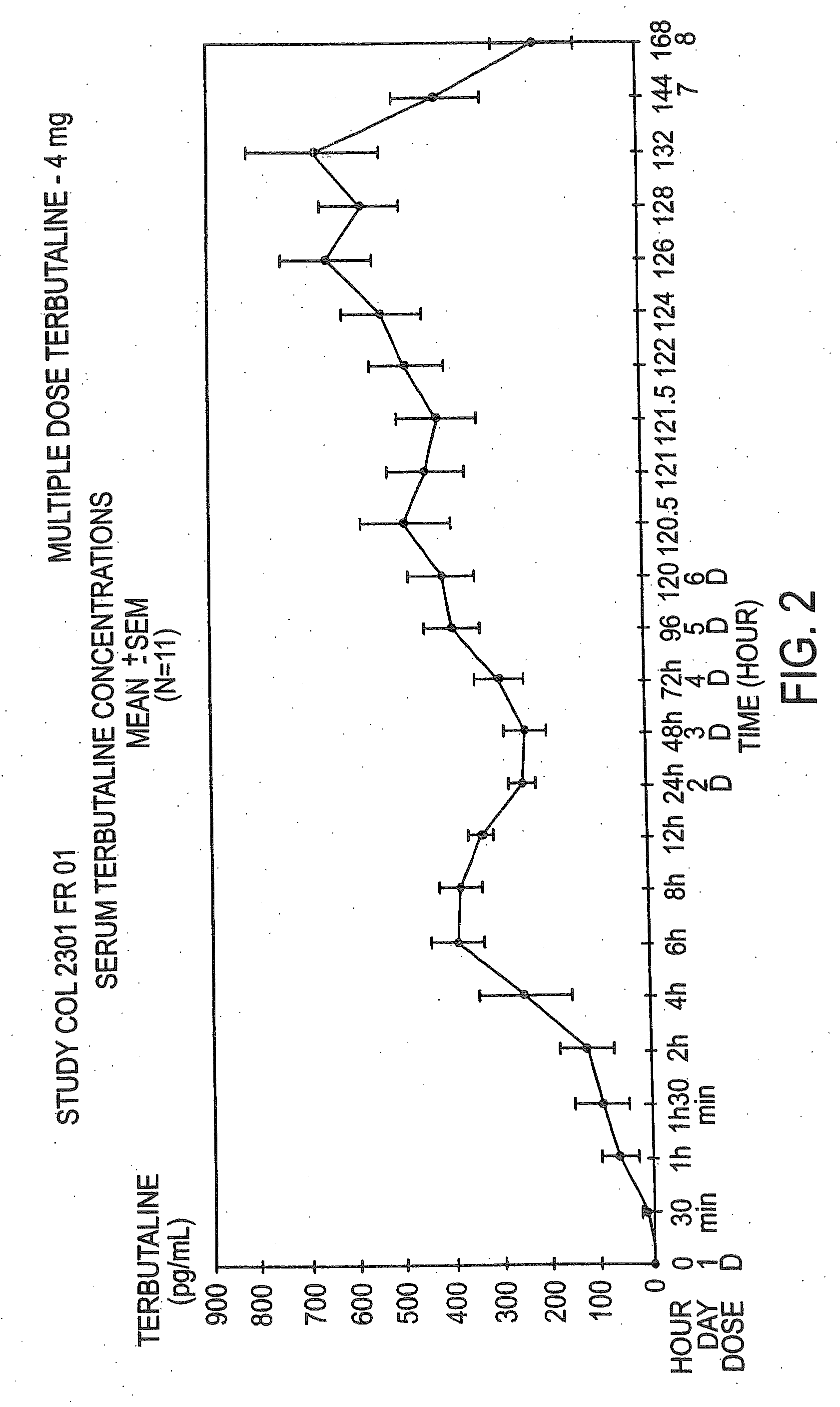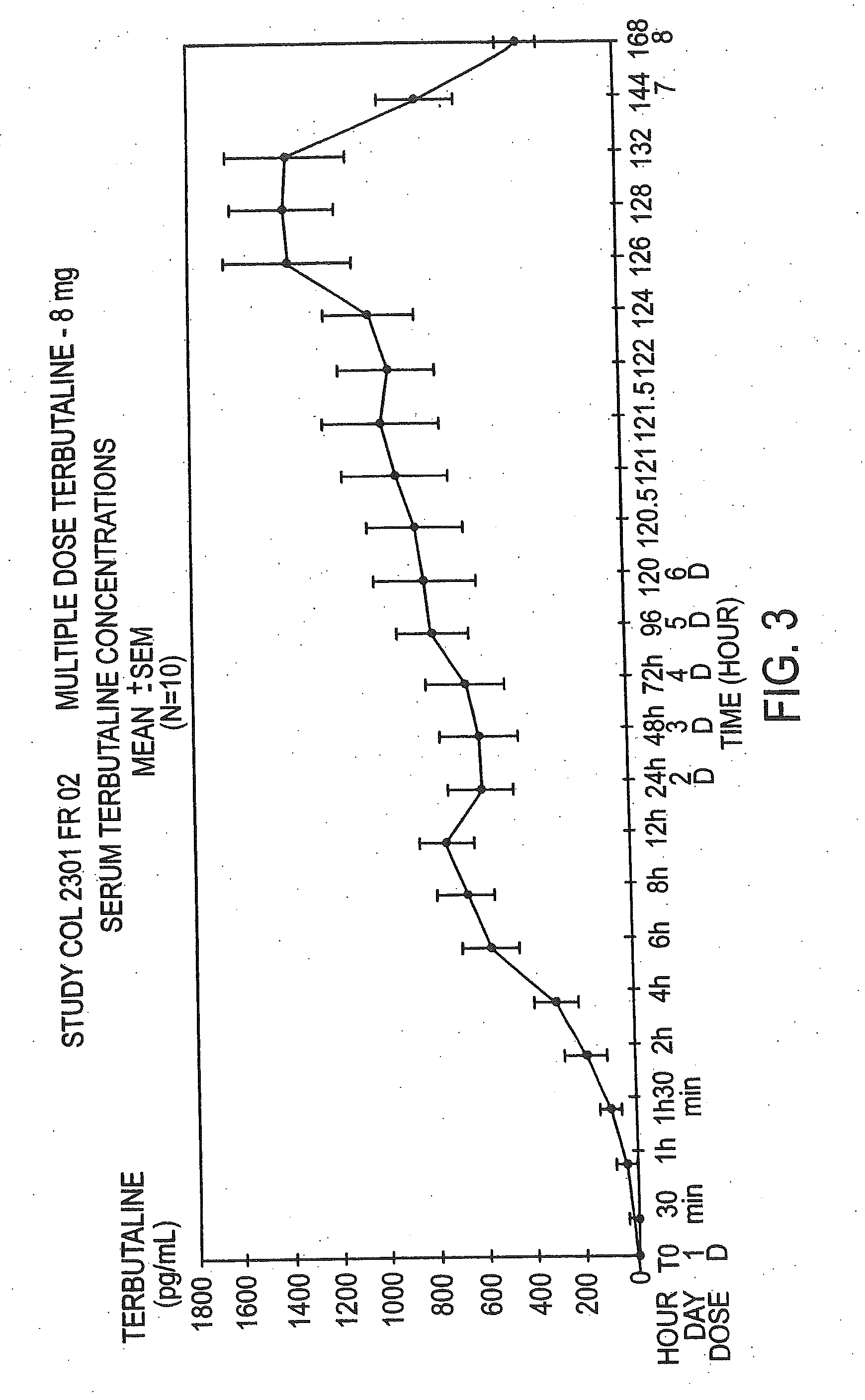Localized vaginal delivery without detrimental blood levels
a vaginal delivery and blood level technology, applied in the direction of peptides/proteins, drug compositions, peptides, etc., can solve the problems of frequent absenteeism or loss of activity, the treatment regimen for both conditions is still lacking, and the estimated 140 million work and school hours are lost per year
- Summary
- Abstract
- Description
- Claims
- Application Information
AI Technical Summary
Benefits of technology
Problems solved by technology
Method used
Image
Examples
example 1
The Pharmacokinetic Parameters of the Terbutaline Composition, a Single Dose Study
[0060]The objective of this study was to assess the pharmacokinetic parameters of the terbutaline and polycarbophil composition following a single dose regimen comparing progressively increasing concentrations. This open-label study was conducted in ten healthy female volunteers with a mean age of 25±SD (Standard Deviation) of 3.93 years. This study consisted of a 30 day screening period and a 24 hour treatment period with a follow-up evaluation conducted two days after administration of the final dose. The drug was administered transvaginally at 9:00 a.m. A wash out period of at least one week as observed between each of the four doses of the drug. All subjects were given an estro-progestative pill, to ensure that all study participants were at the same point in their menstrual cycle. They began dosing on day 7 to 10 of their pill intake for the single dose study. Serum terbutaline concentrations were...
example 2
The Pharmacokinetic Parameters of the Terbutaline Composition, a Multiple Dose Study
[0062]The multiple dose study was an open-label study conducted in 12 healthy female volunteers with a mean age±SD of 25±4.13 years. The dose used in this study was 0.4%. This study consisted of a 30 day screening period, a 6 day treatment period, and a 2 day follow-up. The drug was administered transvaginally once daily at 9:00 a.m. All subjects were given an estro-progestative pill, to ensure that all study participants were at the same place in their menstrual cycle. They began dosing on day 13 to 16 of their pill intake for the multiple dose study. Serum terbutaline concentrations were obtained from blood samples collected predosing on the mornings of treatment, at frequent intervals during the initial 24 hours post-dose (0.5, 1, 1.5, 2, 4, 6, 8, 12, and 24 hours), and at 48 hours post-dose. Samples were also obtained just before each administration and at regular intervals after the last dose (0...
example 3
A Dose Comparison
[0064]Both the single and multiple dose studies discussed in the preceding examples also evaluated the 0.8% w / w concentration. The average age±SD for the single and multiple dose studies at the 0.8 dose were 26±3.42 and 26±4.12 respectively. The pharmacokinetic parameters from the study follow in Tables 4 and 5.
TABLE 4SINGLE DOSE STUDY, PHARMACOKINETIC PARAMETERSSingle DoseStudyPharmacokinetic Parameters (means ± SEM)TerbutalineAUC0 to 48DosenCmax (pg / mL)Tmax (h)CSS (pg / mL)t1 / 2 (h)(pg · h / mL)0.8%8787 ± 43410 ± 3579 ± 30020 ± 723222 ± 13530
TABLE 5MULTIPLE DOSE STUDY, PHARMACOKINETIC PARAMETERSMultiplePharmacokineticDose StudyParameters (mean ± SEM)TerbutalineAUC0 to 48DoseDaynCmax (pg / mL)Tmax (h)CSS (pg / mL)t1 / 2 (h)(pg · h / ml)0.8%110794 ± 39411 ± 5 567 ± 322—13618 ± 77180.8%6101537 ± 906 9 ± 21135 ± 679 19 ± 4 27246 ± 16299
[0065]As can be seen in FIGS. 3 and 4, the serum terbutaline levels in both cases did not reach known levels for toxicity (3000 pg / ml), nor did the...
PUM
| Property | Measurement | Unit |
|---|---|---|
| Time | aaaaa | aaaaa |
| Fraction | aaaaa | aaaaa |
| Concentration | aaaaa | aaaaa |
Abstract
Description
Claims
Application Information
 Login to View More
Login to View More - R&D
- Intellectual Property
- Life Sciences
- Materials
- Tech Scout
- Unparalleled Data Quality
- Higher Quality Content
- 60% Fewer Hallucinations
Browse by: Latest US Patents, China's latest patents, Technical Efficacy Thesaurus, Application Domain, Technology Topic, Popular Technical Reports.
© 2025 PatSnap. All rights reserved.Legal|Privacy policy|Modern Slavery Act Transparency Statement|Sitemap|About US| Contact US: help@patsnap.com



